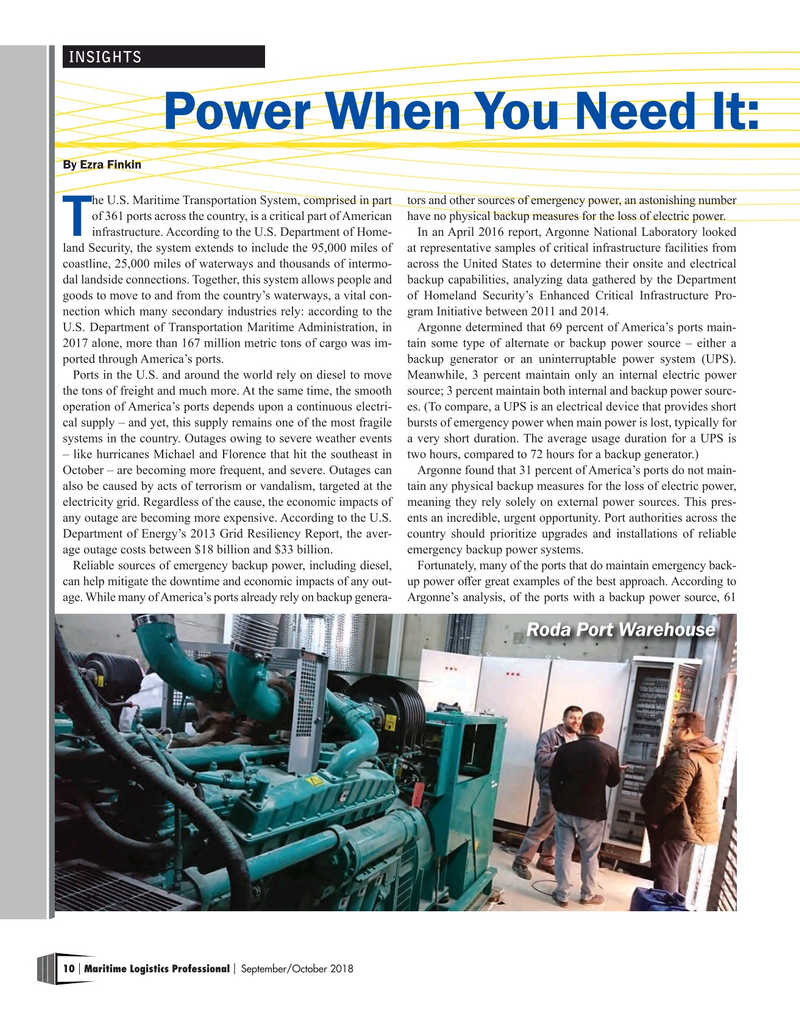
Page 10: of Maritime Logistics Professional Magazine (Sep/Oct 2018)
Liner Shipping & Logistics
Read this page in Pdf, Flash or Html5 edition of Sep/Oct 2018 Maritime Logistics Professional Magazine
INSIGHTS
Power When You Need It:
By Ezra Finkin he U.S. Maritime Transportation System, comprised in part tors and other sources of emergency power, an astonishing number of 361 ports across the country, is a critical part of American have no physical backup measures for the loss of electric power.
Tinfrastructure. According to the U.S. Department of Home- In an April 2016 report, Argonne National Laboratory looked land Security, the system extends to include the 95,000 miles of at representative samples of critical infrastructure facilities from coastline, 25,000 miles of waterways and thousands of intermo- across the United States to determine their onsite and electrical dal landside connections. Together, this system allows people and backup capabilities, analyzing data gathered by the Department goods to move to and from the country’s waterways, a vital con- of Homeland Security’s Enhanced Critical Infrastructure Pro- nection which many secondary industries rely: according to the gram Initiative between 2011 and 2014.
U.S. Department of Transportation Maritime Administration, in Argonne determined that 69 percent of America’s ports main- 2017 alone, more than 167 million metric tons of cargo was im- tain some type of alternate or backup power source – either a ported through America’s ports. backup generator or an uninterruptable power system (UPS).
Ports in the U.S. and around the world rely on diesel to move Meanwhile, 3 percent maintain only an internal electric power the tons of freight and much more. At the same time, the smooth source; 3 percent maintain both internal and backup power sourc- operation of America’s ports depends upon a continuous electri- es. (To compare, a UPS is an electrical device that provides short cal supply – and yet, this supply remains one of the most fragile bursts of emergency power when main power is lost, typically for systems in the country. Outages owing to severe weather events a very short duration. The average usage duration for a UPS is – like hurricanes Michael and Florence that hit the southeast in two hours, compared to 72 hours for a backup generator.)
October – are becoming more frequent, and severe. Outages can Argonne found that 31 percent of America’s ports do not main- also be caused by acts of terrorism or vandalism, targeted at the tain any physical backup measures for the loss of electric power, electricity grid. Regardless of the cause, the economic impacts of meaning they rely solely on external power sources. This pres- any outage are becoming more expensive. According to the U.S. ents an incredible, urgent opportunity. Port authorities across the
Department of Energy’s 2013 Grid Resiliency Report, the aver- country should prioritize upgrades and installations of reliable age outage costs between $18 billion and $33 billion. emergency backup power systems.
Reliable sources of emergency backup power, including diesel, Fortunately, many of the ports that do maintain emergency back- can help mitigate the downtime and economic impacts of any out- up power ofer great examples of the best approach. According to age. While many of America’s ports already rely on backup genera- Argonne’s analysis, of the ports with a backup power source, 61
Roda Port Warehouse 10 Maritime Logistics Professional September/October 2018 | |

 9
9

 11
11
